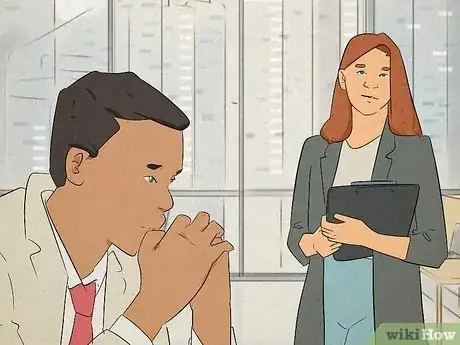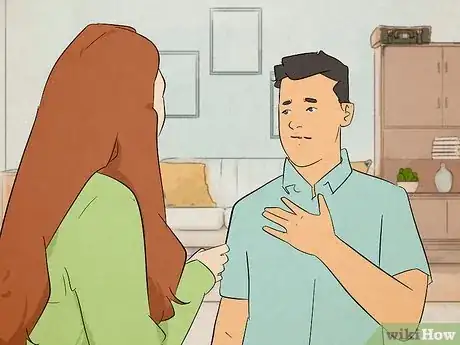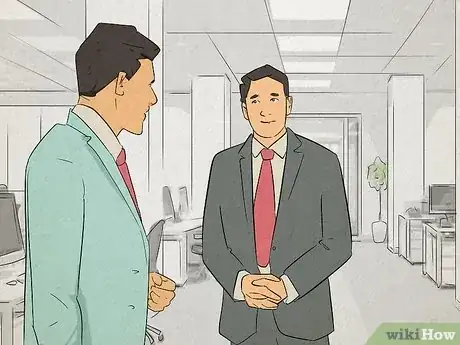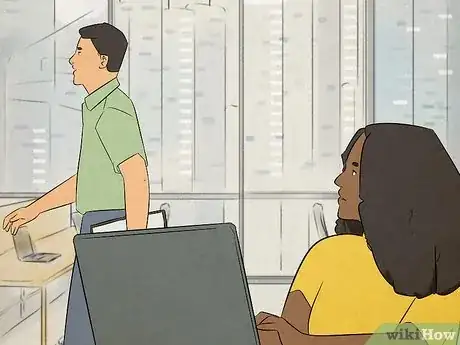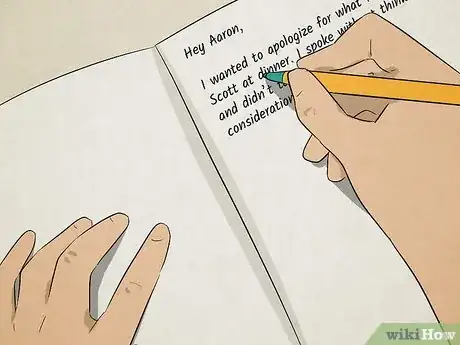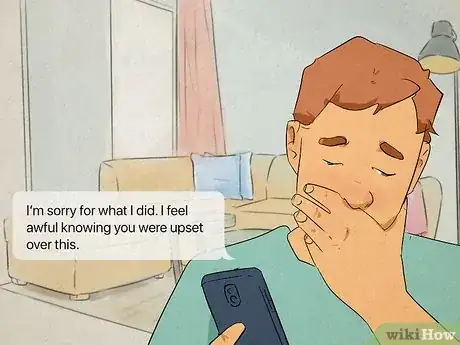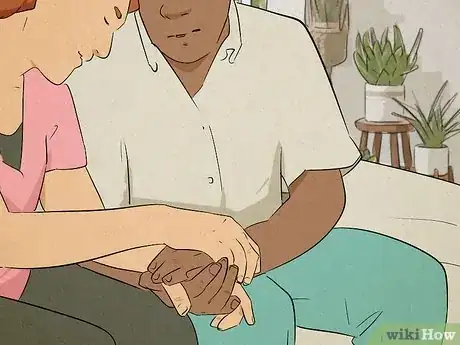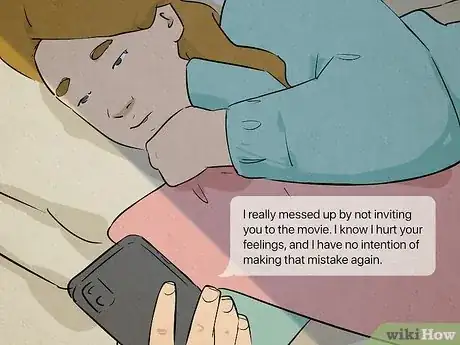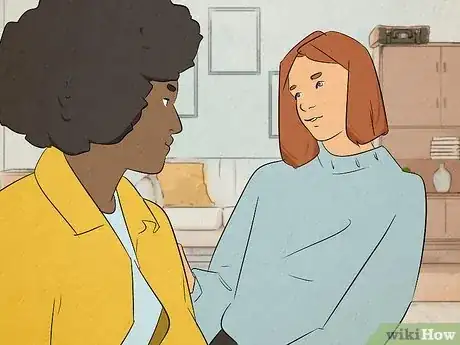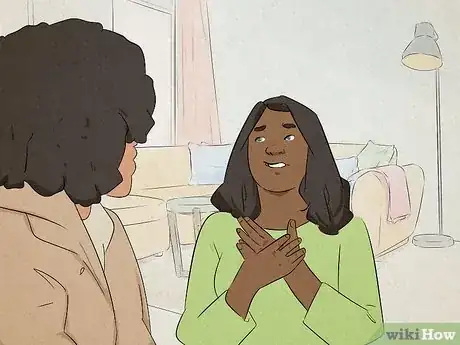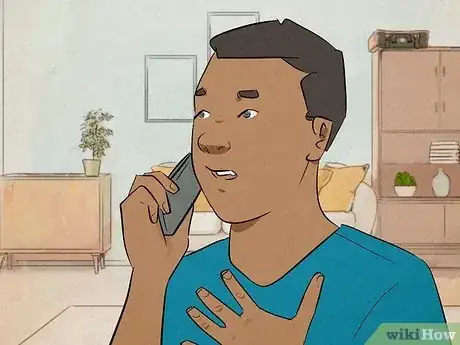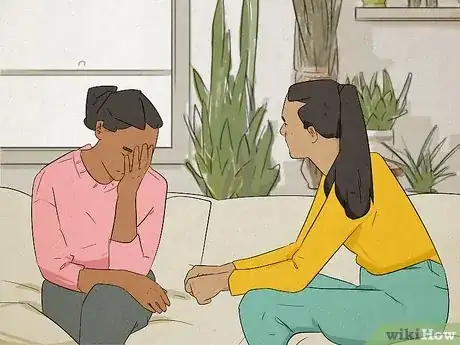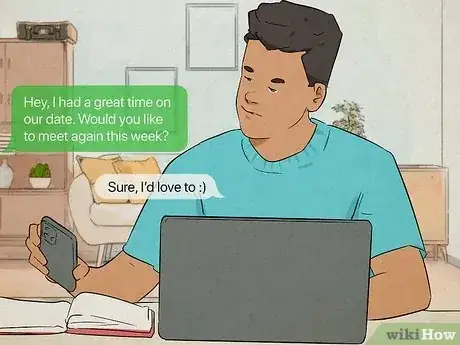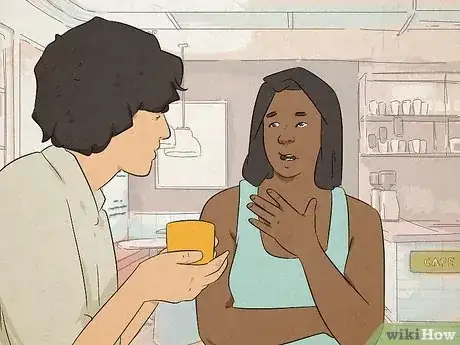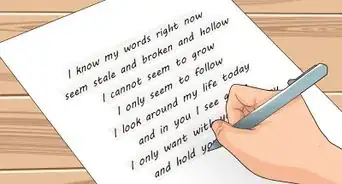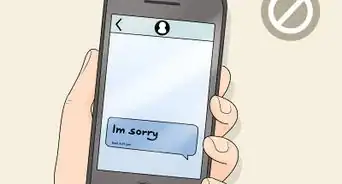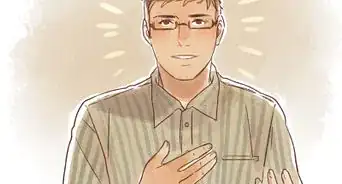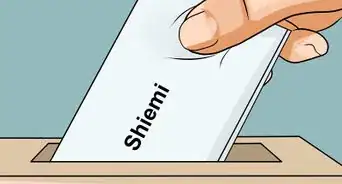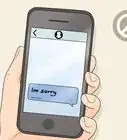This article was written by Gera Anderson, PsyD and by wikiHow staff writer, Glenn Carreau. Dr. Gera Anderson is a Licensed Clinical Psychologist with more than five years of experience. She specializes in integrated behavioral health, neuropsychological assessment, and pain management, and has worked in community mental health settings, correctional facilities, psychiatric hospitals, and schools. Dr. Anderson received an MEd from The University of Minnesota, Twin Cities and a PsyD in Clinical Psychology from Pepperdine University.
There are 8 references cited in this article, which can be found at the bottom of the page.
This article has been viewed 4,387 times.
Are you worried that you may have hurt someone’s feelings unintentionally and don’t know how to make things right? We’re here to help you out. Everyone makes mistakes, but learning to apologize for them can help you maintain happy relationships in your life. Read on, and we’ll teach you how to recognize unintentional mistakes, why they deserve an apology, and how to craft your own heartfelt apology.
This article is based on an interview with our licensed clinical psychologist, Gera Anderson. Check out the full interview here.
Things You Should Know
- Resist the urge to get defensive when you hurt someone unintentionally. If they’re upset over what happened, it’s important to apologize to them.
- Acknowledge the other person’s feelings in your apology. Then, take responsibility for what happened.
- The most important elements of a good apology are sincerity and regret. Someone is more likely to forgive you when they see you’re truly sorry.
Steps
Why should you apologize if you didn’t mean to hurt someone?
-
1Apologizing is kinder and more considerate than getting defensive. If you didn't mean to hurt someone, the prospect of taking responsibility might make you feel defensive. It might feel unfair to take responsibility for an unintentional mistake. Although your actions may have been well-intended, apologizing isn't about that; it's about acknowledging how your actions made the other person feel.[2]
- It’s extremely important to move past any feelings of defensiveness you might feel after hurting someone unintentionally.
- Accept that harm happened, whether or not you meant to do it, and you are therefore responsible for it —and for making amends.
-
2Making apologies can be uncomfortable, but it shows your maturity. Apologizing is a daunting thing for many people, and when you don’t even realize you were doing something wrong, it can be even more of a struggle. Realizing you hurt someone by accident can make you feel anxious, uneasy, or shocked, but your ability to move past those feelings and apologize is a sign of courage and compassion.[3]
-
3Hurting a person can cause them to act differently around you. You can usually tell if someone is hurting by their behavior. They might be angry, upset, or sad, which can affect their attitude toward you. You may even notice that they’ve been avoiding you. To them, your mistake warrants an apology, even if you don't realize it.[4] Other signs someone is upset with you include:
- Their tone of voice changes when they interact with you.
- They seem less engaged in your conversations than usual.
- They have detached body language, including crossed or folded arms.
- Their face seems tense or unhappy.
- They seem strangely reluctant to spend time with you.
How to Make a Good Apology
-
1Prepare beforehand so you can give a thoughtful apology. Planning out your apology can help you organize your thoughts, making it easier to say exactly what you mean to say in the moment. It’ll also help your official apology sound more natural and meaningful because you took the time to think through what you wanted to say first.[5]
- Try writing a basic outline of your apology if you plan on verbally delivering it in person. That way, you’ll know the most important talking points and will likely feel better knowing you have a plan.
- If you’re sending a written apology to someone, ask a couple of people you trust to proofread it first.
-
2Be sincere so the other person can see you mean what you say. Sincerity is the most important part of any apology because it proves that your words are trustworthy. If you say something insincerely, they might find it hard to believe you—and, in the long run, forgive you. Be genuine so they can see you know you did something wrong and truly regret it.[6] To show sincerity, you can:
- Use sincere body language. Make eye contact while keeping your body relaxed and angled toward the person you’re apologizing to.
- Use a natural tone of voice to show the other person you’re speaking from the heart. Avoid speaking in a stiff, flat tone.
- Always be honest and speak your truth without being condescending or rude.
- Say the other person’s name in your apology to convey respect and sincerity.
- Empathize with the other person. Put yourself in their shoes and consider how they feel so you can offer a more genuine and thoughtful apology.
-
3Express genuine regret for what you did. When you hurt someone intentionally, it’s important to let them know how sorry you are. Tell them you regret your actions and you regret that they hurt the other person. If you say “sorry” without expressing true regret, the other person might assume you don’t really care that you hurt them. That’s why feeling and expressing regret is critical to a good apology.[7]
- For example, you might say, “I’m sorry for what I did. I feel awful knowing you were upset over this.”
- Don’t turn the apology into a debate by saying, “I’m sorry if I hurt you,” or “I’m sorry, but I didn’t think you’d mind.” Even unintentionally, you hurt them, so the best thing to do is say “I’m sorry” without being defensive.
-
4Explain what happened and why using detailed “I” statements. Make your apology stronger by showing you fully understand the situation. Include details about what happened, why it happened, and what you plan to do about it. Naming what happened won’t make up for the mistake, but it helps the other person see you that understand what went wrong and why your actions were harmful.[8]
- If a friend felt neglected because you didn’t include them, you could say, “I didn’t think to invite you to the movies. I assumed you wouldn’t want to go since you don’t like horror films, but I should’ve asked anyway.”
- Using “I” statements (like in the example above) is also an important part of apologizing. When you describe a situation, focus on yourself and what you did. “I” statements help you take direct responsibility for what happened.
- Remember: offering clarity doesn’t mean making excuses. All you need to do is objectively describe the situation and then acknowledge where you went wrong.
-
5Acknowledge the other person’s feelings to show them you care. Even if your intentions were good, they led to a mistake that harmed someone. In your apology, directly acknowledge that you hurt them. Describe how your mistake made them feel and emphasize your remorse for their emotional turmoil so they can see you care and want to understand the situation better.[9]
- For example: “Thank you for sharing your feelings with me. I can see that my actions made you feel excluded, and that was never my intention.”
- Acknowledge that they’re hurting without trying to undercut or downplay it. For example, “I’m sorry that my actions hurt you so badly” is a good way to describe the impact of your mistake.
- The more upfront you are about acknowledging the other person’s hurt feelings, the more they’ll likely appreciate your apology.
-
6Take responsibility for your mistake and accept the blame for it. Admitting that you’re at fault for the other person’s hurt feelings can go a long way toward earning their forgiveness. It can be tough to admit you’re in the wrong, but taking responsibility for what you did (and how it affected the other person) shows that you’re a mature, courageous, and thoughtful person.[10]
- For example: “I really messed up by not inviting you to the movie. I know I hurt your feelings, and I have no intention of making that mistake again.”
-
7Ask for their forgiveness and how you can make it up to them. Making an apology doesn’t mean the other person automatically owes you forgiveness, so asking for it shows care and thoughtfulness. After asking for forgiveness, let them know that you want to make amends, and tell them how you plan to do that. If they can see that you want to do better, they’re more likely to accept the apology.[11]
- For example: “I really hope you can forgive me. In the future, I’m going to check in with everyone before making group plans, no matter what. If there’s anything I can do now to make it up to you, I’m happy to do it.”
- It’s also important to forgive yourself. Yes, feeling regret is an important part of apologizing, but once all is said and done, try to let go of your regret, forgive yourself, and move forward.
-
8Listen actively to the other person and try to understand them better. Rather than rushing to apologize, make an effort to ask them what's wrong and listen to their response. Practice active listening, paying attention rather than preparing a rebuttal. By actively listening to them, you’ll gain more insight into how your mistake impacted them, and you can use that to inform your apology.[12]
- For example, if you’re unsure what you did to offend someone, try asking what’s wrong and listening to their explanation.
- If they say you didn’t call when you were supposed to, you can base your apology on how frustrated and neglected your mistake must have made the other person feel because listening to them gives you that extra perspective.
-
9Give an apology free of excuses, justifications, or shifting blame. Excuses and justifications will only end up undermining your apology. It will likely make the other person feel like you’re refusing to take responsibility for what happened, which can really hurt. No matter how defensive you feel, remember that the easiest way through this is to apologize without trying to excuse what happened.[13]
- Avoid excuses like, “I know this sucks, but it’s not really my fault,” or “In my defense, you didn’t tell me what you wanted me to do.”
- Justifying what you did can also feel like you’re invalidating the other person’s feelings. Avoid saying things like, “Well, even if you didn’t like it, I felt like it was the right thing to do at the time.”
-
10Apologize as soon as you can to stop resentment from growing. The longer you let things sit after unintentionally hurting someone, the more likely they are to develop resentment or pull away from you. Their feelings are hurt, and they’ll likely need some resolution to move past that. Therefore, try to apologize as soon as possible after you realize you made a mistake.[14]
- Since your mistake was unintentional, it’s understandable if you don’t realize there’s a problem right away. The important thing is acting swiftly once you have that realization.
- It’s also perfectly okay to take a little time to collect your thoughts. Don’t rush into an apology if you’re still feeling defensive or unsure what to say; it’s better to give yourself a little time to prepare.
-
11Say you’re sorry to someone in person whenever possible. There are a lot of different ways to apologize, but the most direct and meaningful way to do so is usually face-to-face with the person you hurt. However, depending on personal comfort or the type of relationship you have with this person, it might make sense to apologize another way—over text, by phone, or by email, for example.[15]
- Use your best judgment when determining the type of apology you want to give someone.
- For example, if they won’t meet up with you or you tend to get tongue-tied and want to make sure your apology is as good as it can be, it might make more sense to send a written apology.
- Depending on your relationship with them, you might consider a gift or thoughtful gesture alongside your apology. You could bring them flowers, write them a card, or put together a homemade gift.
Following Up After the Apology
-
1Give them time to process your apology and be patient. Even if you give a heartfelt apology, don’t expect the other person to let go of their hurt or anger and move on right away. They might need some time to process, and that’s okay. Take a step back and give them the time they need, be patient, and be available when they finally reach out to you.[16]
- In your apology, you might even say (or write) something along the lines of “I understand if you can’t accept my apology now, but I want to try to make things right.”
- This shows them that you’re sensitive to their feelings and won’t force them to feel a certain way, making forgiveness more likely.
-
2Commit to changing your behavior without repeating mistakes. After you apologize, the best way to show someone you meant your words is to back them up with actions. Make a point to change your ways, especially if you promised to do so while offering to make things right in your apology. Take actionable steps to prove that you want to do better in the future and win back the other person’s trust.[17]
- For example, if you apologized for accidentally “ghosting” someone for a few days, you could outline your plan to check your phone for messages at specific times and set alarms to get in the habit of replying to them regularly.
- Then, once you decide how to fix your mistake, put those plans into practice. This proves to the other person that you’re more than just talk, and that you sincerely want to make things better.
-
3Be prepared to apologize more than once if necessary. Sometimes, one apology isn’t enough. That won’t always be the case, but depending on the severity of your mistake, the person you accidentally hurt might not be prepared to accept your first apology. Apologize a second time later if they’re willing to hear you out, but remember that your goal with each apology should be making amends—not getting forgiveness.[18]
- Try not to keep on apologizing over and over again, especially if they aren’t receptive to hearing you out.
- Apologizing two or three times might help, but continually saying “I’m sorry” beyond that might wear the other person down.
-
4Do something nice for them to show that you regret your actions. Look for something you can do to make the other person’s life a little easier. You could tackle a chore or errand for them, make dinner for them, give them a ride somewhere, or do anything else you don’t normally do for them. Helping out can prove to them you’re sorry and that you’d like to make a difference in whatever way you can.[19]
- Offer your help directly instead of waiting to be asked. Be proactive to show them you're serious about your desire to help.
- Remember: if they refuse your help, don’t force it on them. Just keep asking now and again, gently, until they’re willing to let you help.
References
- ↑ https://www.apa.org/news/podcasts/speaking-of-psychology/apologize
- ↑ https://www.psychologytoday.com/us/blog/the-squeaky-wheel/201305/5-reasons-why-some-people-will-never-say-sorry
- ↑ https://www.psychologytoday.com/us/blog/the-squeaky-wheel/201305/5-reasons-why-some-people-will-never-say-sorry
- ↑ https://www.health.harvard.edu/blog/the-art-of-a-heartfelt-apology-2021041322366
- ↑ https://www.psychologytoday.com/us/blog/evolution-the-self/202110/7-dos-and-3-donts-after-you-accidentally-offend-someone
- ↑ https://www.psychologytoday.com/us/blog/divorce-grownups/200903/how-apologize-woman
- ↑ https://www.health.harvard.edu/blog/the-art-of-a-heartfelt-apology-2021041322366
- ↑ https://www.health.harvard.edu/blog/the-art-of-a-heartfelt-apology-2021041322366
- ↑ https://www.health.harvard.edu/blog/the-art-of-a-heartfelt-apology-2021041322366
- ↑ https://www.health.harvard.edu/blog/the-art-of-a-heartfelt-apology-2021041322366
- ↑ https://www.health.harvard.edu/blog/the-art-of-a-heartfelt-apology-2021041322366
- ↑ https://www.psychologytoday.com/us/blog/evolution-the-self/202110/7-dos-and-3-donts-after-you-accidentally-offend-someone
- ↑ https://www.psychologytoday.com/us/blog/evolution-the-self/202110/7-dos-and-3-donts-after-you-accidentally-offend-someone
- ↑ https://psychcentral.com/blog/psychology-self/2017/11/forgiveness-apologizing-responsibility#1
- ↑ https://psychcentral.com/blog/psychology-self/2017/11/forgiveness-apologizing-responsibility#1
- ↑ https://psychcentral.com/blog/psychology-self/2017/11/forgiveness-apologizing-responsibility#1
- ↑ https://psychcentral.com/blog/psychology-self/2017/11/forgiveness-apologizing-responsibility#1
- ↑ https://www.psychologytoday.com/us/blog/growing-friendships/202106/the-5-worst-ways-apologize
- ↑ https://www.regain.us/advice/general/i-didnt-mean-to-hurt-you-10-ways-to-say-youre-sorry/
